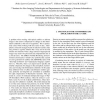Free Online Productivity Tools
i2Speak
i2Symbol
i2OCR
iTex2Img
iWeb2Print
iWeb2Shot
i2Type
iPdf2Split
iPdf2Merge
i2Bopomofo
i2Arabic
i2Style
i2Image
i2PDF
iLatex2Rtf
Sci2ools
IGARSS
2009
2009
Affine Compensation of Illumination in Hyperspectral Remote Sensing Images
A problem when working with optical satellite or airborne images is the need to compensate for changes in the illumination conditions at the time of acquisition. This is particularly critical when working with time series of data. Atmospheric correction strategies based on radiative transfer codes may provide a rigorous solution but it may not be the best solution for situations where a huge amount of hyperspectral images may need to be processed and computational time is a critical factor. The GMES ("Global Monitoring for Environment and Security") initiative has promoted the creation of a new generation of satellites (the SENTINEL series) with "ultra-high resolution" and "superspectral imaging" capabilities [1]. Therefore, there is an urgent need to quickly and reliably compensate for changes in the atmospheric transmittance and varying solar illumination conditions. In this paper three different forms of affine transformation models (general, particula...
| Added | 20 Feb 2011 |
| Updated | 20 Feb 2011 |
| Type | Journal |
| Year | 2009 |
| Where | IGARSS |
| Authors | Pedro Latorre Carmona, Jose Moreno, Filiberto Pla, Crystal Schaaf |
Comments (0)

